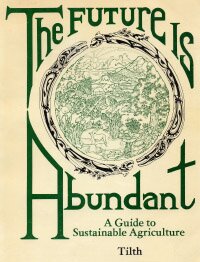
The Future is Abundant
A Guide to Sustainable Agriculture
Tilth Producers of Washington Home | WA Tilth Assoc. | Conference | Directory | Journal | Placement Service | Calendar | Action Alerts
Legislative Update | Bulletin Board | Classifieds | Questions on Agriculture? | Photo Gallery | Links | Contact Us | Join Now | Volunteer

Design is the process of creating patterns which unite elements in an integrated whole. "Permaculture" is a word coined by Bill Mollison and the Tagari group in Australia to describe the conscious design of self-sustaining agricultural landscapes. Rather than dominating the environment, permaculture seeks to enhance it. The goal of permaculture design is to integrate livestock, food production, and human shelters in an agriculture which embodies the stability and resilience of natural ecosystems.
Below is an excerpt from a report by Maia Massion on permaculture design principles. Her complete article was published in the Fall, 1981 issue of Tilth.
The most important skill a designer or steward can develop is the ability to see clearly what is occurring in the landscape. Keen observation and careful notation of even the most minute or mundane natural phenomena is important. Essential information about the ecology, history, and potential productivity is revealed, for example by rocks, insects, trees and shifting air currents. All are indicators of the flow of life and energy across the landscape. Awareness of the ecology and patterns created by these flows is fundamental in assessing the resources, limitations and potential of the site, and is the basis for developing designs for sustainable agriculture.
Site strategy and tactics are important aspects of the overall permaculture design process. The "strategy" for a site refers to planning its development and management through time. For example, strategizing for proper woodlot management involves planning a diverse succession of species suitable to fuel, timber and animal fodder production over the years.
Design "tactics" are simply the techniques of management or production. Coppicing is an example of a tactic or technique that can be implemented for sustained woodlot management.
Site zonation and sector planning help determine the placement of elements in the landscape. "Zones" emanate outward in concentric circles from the center of greatest activity on site. This is usually the main dwelling, designated as Zone 1. Zone 2 would be the area immediately surrounding the house. Zone 3 would begin beyond the back yard, and so on. Larger acreages may even encompass a Zone 5, the domain of forest woodlands and wildlife.
Elements are placed in zones according to the maintenance and harvest activity they require. Chicken sheds and greenhouses, needing daily attention, would be located in Zone 2. Sporadic and seasonal visitations to the woodlot indicate that it could be located in Zone 4.
"Sectors" are wedges of the zonation circle. They are delineated according to site orientation and relations to sun angles, wind directions and fire patterns. Thus the optimal location for a water reservoir needed for agricultural and/or human use would be in the sector from which fires are most likely to enter and threaten the site. The reservoir could then also function as fire prevention and control. Woodlots as effective windbreaks could be established in the sector defined by the direction of cold winter winds.
The stability of a system is its ability to withstand stress and continue functioning in a productive manner. Diversity is the number of different elements in the system, and complexity is the number of functional relationships between those elements. Diverse polyculture systems of mixed plant and animal species are more productive than monocrop systems because energy is captured, stored and utilized in so many different ways.
Natural ecosystems and permaculture designs tend toward maximizing diversity and complexity. Stability is insured if every function of the system is fulfilled by several different elements, and if every element fulfills several functions. For example, if there are several sources of chicken feed (mulberries, acorns, grains, greens, insects, kitchen garbage), then the function of feeding the chickens will still be fulfilled if a few crops fail. Meanwhile, the chicken is functioning as a mulberry- or acorn-into-egg transformer, biological pest controller and "fertilizer tractor" for the garden.
Successful permaculture design requires a subtle and profound evolution in thinking which shifts the emphasis from the object to its function. Even our language is object-oriented. We use the word "tree," while some other, more functionally oriented culture might refer to the same being as "giver of shade and fruit."
As people learn more about permaculture they have many real and very challenging questions about the specific applications of its principles and methods. Permaculture experimentation involves uncertain economic parameters and potential financial risk.
A lot of the information people desire concerning permaculture economics and applied ecology does not yet exist for the Pacific Northwest. Each bioregion will need to develop its own specific permaculture techniques and sustainable agriculture strategies according to its own people, economics, climate and appropriate plant and animal species. The exchange of information and mutual support, especially through bioregional networks, will be essential in facilitating the development of Pacific Northwest permaculture and in the evolution of a sustainable, ecological agriculture with which we can heal the earth and support ourselves.
Tilth Producers of Washington Home | WA Tilth Assoc. | Conference | Directory | Journal | Placement Service | Calendar | Action Alerts
Legislative Update | Bulletin Board | Classifieds | Questions on Agriculture? | Photo Gallery | Links | Contact Us | Join Now | Volunteer